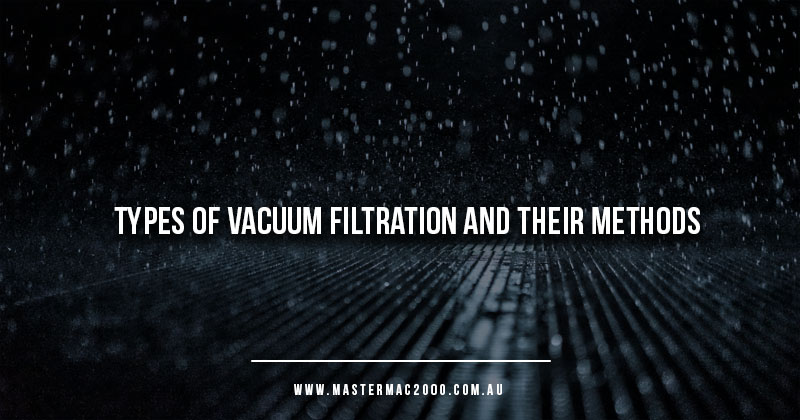Types of Vacuum Filtration and Their Methods
What are the different types of vacuum filtration and the involved methods?
Vacuum filters are used in removing particles in the direction of suction. And in order to identify the filter cartridge’s degree of contamination, it is located in a transparent bowl, and this filter cartridge is replaceable. Did you know that there are different vacuum filtrations that are used in various application? Here are as follows including the methods involved.
Chemical Filtration
This type of vacuum filtration changes the physical characteristic of a vapour or gas. They are used to adsorb toxic mercury vapours and then exhaust clean air into the surrounding environment.
Mechanical Filtration
In this type of filtration, particles are collected and retained in a physical barrier. Usually, it is with a series of cloth, paper filters and/or polyethylene that treat the intake air particulate or working of vacuum and exhaust clean air back into the environment.
There are factors that influence mechanical filtration of which include the air velocity at which the substance is travelling, the amount of time the filter has been used, the filter media, and the particle size of the substance being captured.
Air Velocity
This refers to the pace at which the particles move through the hose and then into the vacuum cleaner. The deeper the particles penetrate the filter media if they travel faster, for a particle travelling at a higher speed have the ability to push through the pores of the filter material. On the other hand, the particles that travel at a lower speed are easy to be captured on or between the weave or fibres of the filter media.
Running Time
Over the course of time, particles will gather up on the filter’s surface and then attach itself to the filter material, and such action of clogging is called filter loading or blinding. Just before the particles totally clog the filter pores, that is when the filter is most efficient, for the pores are smaller becoming a finer filter. The downside of this is that the vacuum cleaner’s performance is decreased for there is only little to no airflow to move the particles.
Filter Media
Depending on the link between the volume of air and the filter media’s surface area, it affects the filtering efficiency, known as the air-to-cloth (ATC) ratio. The more efficient the filtering system if the ATC is lower. Similarly, the less efficient the filtering system if the ATC is higher.
The optimum condition is a slow airflow through a large filter. Designed with this in mind, Nilfisk vacuum cleaners are equipped with oversized main filters to lower the air-to-cloth ratio.
Particle Size
Since filter media are too porous for small particles, they can easily penetrate. Simply, the smaller the particle, the tougher it is to be filtered.
Multi-Stage Filtration
This is a filtration system that is composed of a series of finer filters and is oversized and multi-stage. Such system captures smaller particles as the air travels through a vacuum cleaner.
Should you have concerns regarding vacuum filtration, comment down below!

About MasterMac2000: Your Trusted Pneumatic & Process Automation Partner.
LEADING THE INDUSTRY: Established in 1989, MasterMac2000 has grown to become one of Australia's largest privately owned pneumatic and process automation companies. We stock top-quality brands like Univer, Mack, Tolomatic, Mac, Piab, American, and Rotoflux in Brisbane.
SERVING QLD & NORTHERN NSW: We proudly service Queensland and Northern New South Wales for all your pneumatic and process equipment needs. Our mission is to provide the best pre and post-sales support while actively expanding our client base.
SOURCING HARD-TO-FIND PARTS: Not only do we stock quality components, but we also excel at sourcing those elusive, hard-to-find parts. With our extensive database and global network of contacts, getting the parts you require is as easy as a call to our highly skilled, professional sales team.
DEDICATED TO YOUR SUCCESS:
- Decades of expertise in pneumatics & process automation
- Carefully curated selection of world-class brands
- Exceptional sourcing capabilities for speciality parts
- Knowledgeable sales staff dedicated to finding solutions
- Unwavering commitment to customer service excellence
About The Author
Stuart Havill
Stuart Havill is the owner and manager of MasterMac2000, Queensland's largest privately owned pneumatic and process valve company.
With his early working career as a maintenance fitter for Boral in 1992, Stuart has spent his life in the field of pneumatics and process equipment. He gained extensive experience in plant design, maintenance, repairs, fabrication, and site management.
In 1996, he transitioned to a pneumatic sales technician role at MasterMac2000, where he excelled in key account management, providing cost-effective solutions, and managing a sales team of 9 employees.
Since 2002, Stuart has been the manager at MasterMac2000, overseeing the company's growth and establishing it as a leader in pneumatic automation and process valve engineering. His expertise spans customer training, CRM setup, industrial compressor sizing and installation, and turn-key project management.
Under Stuart's leadership, MasterMac2000 has been servicing the industry since 1988, with 5 full-time sales representatives covering northern rivers NSW, Queensland, Northern Territory, and PNG. The company prides itself on providing the best-priced solutions to all customers in the marketplace.
View Stuart’s LinkedIn profile to learn more about his expertise in pneumatics and process equipment.
